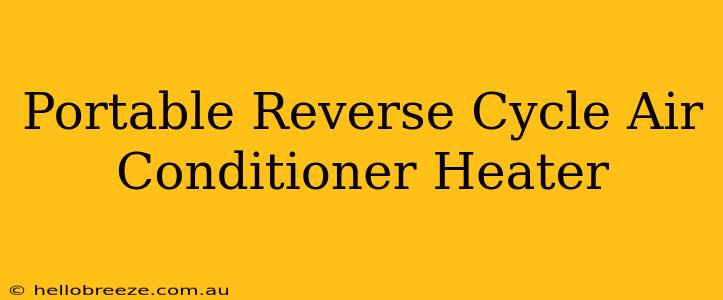Staying comfortable throughout the year can be a challenge, especially if you live in a region with extreme temperature fluctuations. A portable reverse cycle air conditioner heater offers a convenient and effective solution, providing both cooling relief in the summer and warming heat in the winter. This comprehensive guide will explore the benefits, features, and considerations when choosing the right portable reverse cycle unit for your needs.
What is a Portable Reverse Cycle Air Conditioner Heater?
A portable reverse cycle air conditioner heater is a versatile appliance that functions as both an air conditioner and a heater. Unlike traditional units, it doesn't require complex installation. Its portability allows you to move it from room to room as needed, offering targeted climate control where you need it most. The "reverse cycle" refers to its ability to switch between heating and cooling modes using a single system, offering significant energy efficiency compared to using separate units.
Key Benefits of a Portable Reverse Cycle Unit:
- Versatility: Enjoy both heating and cooling capabilities in one compact unit.
- Portability: Easily move the unit from room to room depending on your needs.
- Cost-Effective: Potentially lower energy bills compared to using separate heating and cooling systems.
- Convenience: No complicated installation required – simply plug it in and go.
- Energy Efficiency: Many models boast high energy efficiency ratings.
Choosing the Right Portable Reverse Cycle Air Conditioner Heater
Several factors should be considered when selecting a portable reverse cycle air conditioner heater:
1. Room Size:
The BTU (British Thermal Unit) rating is crucial. This indicates the heating and cooling capacity of the unit. Choose a unit with a BTU rating appropriate for the size of the room you intend to heat or cool. Underestimating the BTU rating will result in inefficient performance. Larger rooms require higher BTU ratings. Check the manufacturer's guidelines for recommended room sizes for each BTU rating.
2. Features:
Look for features that enhance convenience and comfort:
- Digital Controls: Precise temperature control and convenient programming options.
- Timer: Set the unit to turn on or off automatically.
- Remote Control: Control the unit from a distance.
- Multiple Fan Speeds: Adjust the airflow to your preference.
- Dehumidification: Many units offer dehumidification functions, beneficial in humid climates.
- Sleep Mode: Gradually adjust the temperature for optimal sleep comfort.
3. Energy Efficiency:
Look for units with high energy efficiency ratings (like SEER and HSPF ratings). These ratings indicate how efficiently the unit converts energy into heating and cooling. Higher ratings mean lower energy bills.
4. Noise Level:
Consider the noise level of the unit, especially if you're sensitive to sound. Check the decibel rating in the specifications.
5. Other Considerations:
- Wheels and Handles: Make moving the unit easier.
- Exhaust Hose Length: Ensure the hose is long enough to reach a suitable exhaust point.
- Water Tank Capacity: Check the capacity of the water tank if the unit collects condensate.
Maintaining Your Portable Reverse Cycle Air Conditioner Heater
Regular maintenance will extend the lifespan and efficiency of your unit:
- Clean or replace the air filter regularly: A clogged filter reduces efficiency and can lead to poor air quality.
- Clean the coils: Dust and debris buildup on the coils can negatively impact performance.
- Inspect the exhaust hose: Ensure it's free from obstructions.
Conclusion: Year-Round Comfort at Your Fingertips
A portable reverse cycle air conditioner heater provides a versatile and convenient solution for year-round climate control. By carefully considering your needs and selecting the right unit with the appropriate features and BTU rating, you can create a comfortable and enjoyable indoor environment regardless of the season. Remember to prioritize energy efficiency and regular maintenance for optimal performance and longevity.

